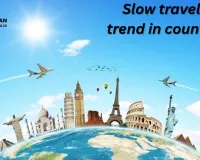USCIS Clarifies H-1B Visa Fees 2025: $100,000 Hike Won't Hit Extensions or Status Changes for US Workers
Digital Desk
In a much-needed update for thousands of skilled foreign workers already calling the US home, the US Citizenship and Immigration Services (USCIS) has clarified that the controversial new $100,000 fee for H-1B visas does not apply to extensions of stay or changes in status. This comes as relief amid the Trump administration's aggressive push to overhaul the popular program, which has long been a gateway for tech talent from countries like India.
The clarification follows widespread confusion after President Trump's September 19, 2025, Proclamation on "Restriction on Entry of Certain Nonimmigrant Workers." Starting at 12:01 a.m. EDT on September 21, 2025, new H-1B petitions—those filed from scratch—must include an additional $100,000 payment (roughly ₹88 lakh) to even be eligible. But USCIS emphasized that this steep one-time charge is strictly for fresh applications, sparing those seeking to extend their current H-1B status or switch jobs within the US.
White House Press Secretary Karoline Leavitt echoed this during a recent briefing, calling the fee a "one-time charge" tied solely to the initial filing. "This is about reforming the system for new entrants, not punishing those already contributing to our economy," she said.
What This Means for H-1B Renewals and Extensions
Good news for H-1B holders eyeing renewals: The visa can be extended for up to three more years at the pre-existing fee structure, which ranges from $5.5 lakh to ₹6.7 lakh (about $650–$800). No ₹88 lakh surprise here—the administration has confirmed that renewals stick to the old rates.
- Initial Application: $100,000 extra fee applies only to new petitions filed after September 21, 2025.
- Extensions/Changes: Exempt from the hike—pay the standard renewal fees.
- Lottery System: Still in play for the annual cap of 85,000 visas, with this fiscal year's applications already wrapped up.
This targeted approach aims to curb what critics call overuse of the program while protecting ongoing contributions from nonimmigrant workers in high-demand fields.
H-1B Visa Basics: A Quick Guide for 2025 Applicants
If you're new to the H-1B world or planning your move, here's the lowdown:
What Is an H-1B Visa?
The H-1B is a nonimmigrant work visa designed for professionals with specialized skills in areas like IT, engineering, architecture, and healthcare. It's not a path to permanent residency on its own but allows US companies to hire top global talent for up to six years (initial three-year term, renewable once).
Due to overwhelming demand—millions apply annually—the US caps it at 85,000 visas per year through a lottery system. Most go to tech giants, fueling Silicon Valley's innovation engine.
Who Gets the Most H-1B Visas?
Last year's data paints a clear picture of the program's reach:
- India leads the pack, snagging the lion's share for its booming tech workforce.
- Amazon topped the list with over 10,000 approvals.
- Microsoft and Meta each secured more than 5,000, highlighting Big Tech's reliance on international hires.
Yet, the program isn't without controversy. American tech workers and unions argue that H-1B visas enable companies to undercut wages and displace domestic employees. Proponents counter that it fills critical skill gaps, boosting the economy by billions.
Why the 2025 H-1B Fee Changes Matter
The Trump administration's reforms signal a broader crackdown on immigration, prioritizing "America First" in hiring. While the $100,000 fee could deter some new applicants, USCIS's clarification ensures minimal disruption for the estimated 500,000+ H-1B holders already in the US.
For the latest on H-1B visa requirements 2025, renewal processes, or how this affects Indian professionals, stay tuned. Employers and applicants should consult USCIS.gov for personalized guidance—deadlines and lotteries wait for no one.











